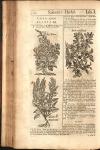


 I. The Names. It is called in Latin, Blitum Rubrum, and in English, the Red Blite.
I. The Names. It is called in Latin, Blitum Rubrum, and in English, the Red Blite.
II. The kinds. There are two Species of it
- 1. Blitum majus Rubrum, Blitum Rubrum Hortense; the greater Red Blite, or Garden Red Blite. (Amaranthus viridis. -Henriette.)
- 2. Blitum minus Rubrum, Blitum Rubrum Sylvestre, the lesser Red Blite, or Wild Red Blite. (Chenopodium capitatum. -Henriette.)
- 3. Red Blite with much Seed. (Amaranthus viridis. -Henriette.)
III. The Description. The first is almost exactly like the Great White Blite described in the former Chapter, except that the Stalks, and Leaves, and also the rest of the Plant are Reddish, and reddish mixed with a dark green color, and in all other respect they seem to be like.
IV. The second, lesser, or Wild Blite, is almost like to the Wild White Blite, saving that in this, the Stalks and Branches trail upon the ground, and are Reddish, like the former for their color: the Seed is small and cluttering together, green of color, and almost like unto the Seed of Coronope Ruellij, or Bucks-horn.
V. The third Kind differs little from the first, save that the Leaves are longer, and it is much fuller of Seed, and with a multiplicity of spiky heads.
VI. The Places. The first or Greater is a Garden Plant, and a Pot-herb: the other grows Wild, but for the most part in Gardens, and is taken for a Weed: but is sometimes found Wild in other places.
VII. The Times. They Flower all the Summer long, and their Seed is ripe in August and September; and keep alive in Winter also.
VIII. The Qualities. They are cold and dry in the second Degree, Astringent, Hysterick, and Solutive.
IX. The Specification. They are peculiar to stop the Terms in Women.
X. The Preparations. You may make therefrom,
-
1. A Liquid Juice.
- 2. An Essence.
- 3. Decoction.
- 4. A Syrup.
The Virtues.
XI. They are exactly the same with those Preparations in the former Chapter, save, that whereas those are peculiar for stopping the Whites in Women, and Gonorrhea’s; these are peculiar for stopping their courses when they overflow; and are also of great use to stop other fluxes of Blood in either Sex.
Botanologia, or The English Herbal, was written by William Salmon, M.D., in 1710.
This chapter has been proofread by Nick Jones.

